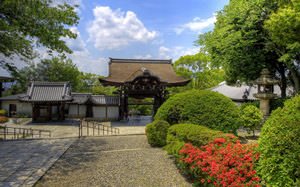 Kyoto is a unique city of festivals - beautiful celebrations are carried out here almost every month. Many celebrations have a long history; a large part of them are devoted to the important religious holidays and historical events. Preparing for the next festival is an important and long-awaited event for all local residents. Citizens have always been active in the organization of cultural events; they adorn city streets and construct public scene at their own expense and consider it their direct duty. All holiday activities are taken as important cultural traditions, and therefore they are treated with such reverence and attention.
Kyoto is a unique city of festivals - beautiful celebrations are carried out here almost every month. Many celebrations have a long history; a large part of them are devoted to the important religious holidays and historical events. Preparing for the next festival is an important and long-awaited event for all local residents. Citizens have always been active in the organization of cultural events; they adorn city streets and construct public scene at their own expense and consider it their direct duty. All holiday activities are taken as important cultural traditions, and therefore they are treated with such reverence and attention.
Kyoto has plenty of shopping spots to choose from. Here you can start shopping right at the railway station. The Kyoto Station Building is one of the largest stations not only in the country …  Open
Open
Discovering the architecture of Kyoto from bird's eye view! Kiyomizu-dera, Kyoto Tower, Tenryu-ji Temple, Chion-in, all those monuments are defining the image of Kyoto …  Open
Open
 Throughout April, visitors to Kyoto have the opportunity to watch charming dances of real geisha (geiko) and their students (maiko). The festival is colorfully called “Miyako Odori”, which translates from Japanese as “dances of the capital” (in this case Kyoto is meant as the cultural capital of the Land of the Rising Sun). Geisha dance in kabuki theaters, while large-scale performances are held at the Gion Kobu Kaburenjo Theater. Attending the festival is a great opportunity to get acquainted with the multifaceted Japanese culture. It is worth noting that this event is popular among both tourists and residents of other Japanese cities flocking to Kyoto during April.
Throughout April, visitors to Kyoto have the opportunity to watch charming dances of real geisha (geiko) and their students (maiko). The festival is colorfully called “Miyako Odori”, which translates from Japanese as “dances of the capital” (in this case Kyoto is meant as the cultural capital of the Land of the Rising Sun). Geisha dance in kabuki theaters, while large-scale performances are held at the Gion Kobu Kaburenjo Theater. Attending the festival is a great opportunity to get acquainted with the multifaceted Japanese culture. It is worth noting that this event is popular among both tourists and residents of other Japanese cities flocking to Kyoto during April.
Kyoto National Museum, Kinkaku-ji, Ryoan-ji, Sanjusangen-do, as well as many others, they all become the world's cultural heritage objects and remain as iconic monuments for Kyoto …  Open
Open
 Another interesting holiday is the Daimonji Gozan Okuribi, which is annually celebrated in the middle of the hot August. Three days before the holidays, locals meet the souls of their deceased ancestors, and on the day of the celebration, they see them off to where they came from. This tradition is known as "Urabon'e". Lights are lit in the mountains around Kyoto (and it must be said that each has its own meaning). Each fire should burn for at least half an hour - this is done so that the spirits cannot get lost in the darkness of the night. After the ceremony, the ancestors' souls will be able to quietly enter the world of the dead, leaving our world for a whole year. The lights are striking in their beauty, and it’s best to admire them from a viewing platform in the center of the Japanese cultural capital.
Another interesting holiday is the Daimonji Gozan Okuribi, which is annually celebrated in the middle of the hot August. Three days before the holidays, locals meet the souls of their deceased ancestors, and on the day of the celebration, they see them off to where they came from. This tradition is known as "Urabon'e". Lights are lit in the mountains around Kyoto (and it must be said that each has its own meaning). Each fire should burn for at least half an hour - this is done so that the spirits cannot get lost in the darkness of the night. After the ceremony, the ancestors' souls will be able to quietly enter the world of the dead, leaving our world for a whole year. The lights are striking in their beauty, and it’s best to admire them from a viewing platform in the center of the Japanese cultural capital.
Until 1868 Kyoto was the residence of the emperor, the capital and the spiritual center of Japan. On the territory of the city are located 17 ancient temples, large number of historical …  Open
Open


